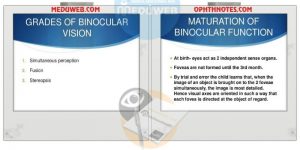Binocular single vision what u have to know
☝️ Binocular single vision simply it is the ability to view the world with two eyes, from two separate images (one from each eye), and fuse two images centrally to create a single image perception .
☝️ Binocular single vision depends on correct ocular alignment and similar image clarity of both eyes from the neonatal period.
☝️ Normal retinal correspondence( NRC) is major factor for BSV , in which an image stimulates anatomically corresponding points on each retina with subsequent stimulation of functionally corresponding points in the occipital cortex producing a single perception.
☝️ Points in space that project to these corresponding retinal points lie on an imaginary plane known as the horopter.
☝️ Panum’s fusional area is the narrow region around the horopter in which, despite disparity, points will be seen as single.

✍️Levels of Binocular single vision:
✍️ Simultaneous perception:
perception of a single image due to
simultaneous formation of an image on each retina.
✍️ Fusion:
stimulation of corresponding retinal points allows stimulation of corresponding cortical points ( visual cortex) causing central fusion of the 2 images .
✍️ Stereopsis:
two retinal images percepted,are not 100% similar but there is some disparity , this disparity in fused images gives a perception of depth.
☝️ Very important to know about Fusion of Binocular single vision:
Fusion has sensory and motor components.
sensory fusion generates a single image from corresponding retinal and cortical points
motor fusion adjusts eye position to maintain sensory fusion.
Fusional reserves indicate the level beyond which these mechanisms break down (usually seen as diplopia)
Horizontal Fusional reserve or amplitude
• For near convergence 32 PD ( Base out )
• For near divergence 16 PD ( Base in)
• For far convergence 16 PD ( Base out )
• For far divergence 8 PD ( Base in)
Vertical fusional reserve or amplitude
• 4 PD (Base up and down )
Abnormalities of Binocular single vision :
Confusion
Stimulation of corresponding points by dissimilar( two different ) images, the two images appear to be on top of each other.
Diplopia
Stimulation of non-corresponding points by the same image (double vision).
Adaptive mechanisms of Binocular single vision :
Suppression:
• cortical mechanism to cancel one of the images
causing confusion (central suppression at the fovea) or the one causing diplopia (peripheral suppression).
• Monocular foveal suppression leads to amblyopia, if not treated
• Alternating suppression (between the two eyes) doesn’t causing Amblyopia
Abnormal retinal correspondence (ARC):
• Cortical mechanism to remap anatomically non-corresponding points of each retina to stimulate functionally corresponding cortical points in the occipital cortex to produce a single perception.
• ARC permits a degree of BSV despite a manifest deviation.
Abnormal head posture
• Behavioural mechanism that brings the field of single vision to a more central location.
❤️Microtropia❤️
• Is a good example of the advantages of adaptive mechanisms for abnormal BSV
• small manifest deviation, usually with a degree of BSV created by a combination of ARC, eccentric fixation, and a central suppression scotoma.
• if no movement on cover test it’s called microtropia with identity
• if movement on cover test ( the eccentric fixation is not absolute) , it’s called microtropia without identity
Tests of Binocular single vision :
Simultaneous perception and fusion
• Worth’s Lights or Bagolini Glasses
when dissimilar images are presented to each eye, and the patient is asked to report what they see.u can determine whether the patient can fuse the dissimilar images.
• Prisms can be used to assess the range of motor fusion ( fusional vergence amplitude) when the patient is instructed to maintain a single image with the introduction of increasing prism power.
Stereoacuity
• three-dimensional tests( Titmus and TNO) based on disparity of images or colour dissociation.
• Stereoacuity is measured in arc- seconds
• Normal disparity perceived is 60 s of arc but may be up to 15 s.
✅The synoptophore is rarely used now.✅
• allows the simultaneous presentation of separate images to each eye.
• Depending on the images presented and the degree of binocular vision, the patient can report simultaneous perception of two images, fusion of two images, or perception of depth in a fused image
Binocular single vision powerpoint presentations :
Binocular single vision basics
Basics of Binocular Single Vision An approach to understand the complexity Indra P Sharma Optometrist
BINOCULAR SINGLE VISION Presented by: Dr. Shrey Maheshwari
Binocular single vision Videos:
Binocular single vision video
Binocularity [ Sub – ENG ] – Binocular Vision video
Binocular single vision


